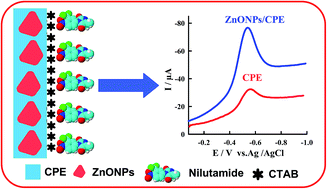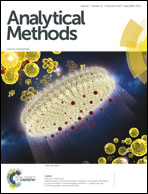Square wave adsorptive stripping voltammetric determination of anticancer drug nilutamide in biological fluids using cationic surfactant cetyltrimethylammonium bromide†
Abstract
A sensitive square wave adsorptive stripping voltammetric method was described for the determination of anticancer drug nilutamide (NLM) in biological fluids based on the enhancement effect of the cationic surfactant: cetyltrimethylammonium bromide (CTAB). With pH 6.0 Britton–Robinson (BR) buffer as the supporting electrolyte and in the presence of 1.45 × 10−4 mol L−1 CTAB, NLM yields a well-defined and sensitive reduction peak at the ZnO nanoparticle modified carbon paste electrode (ZnONPs/CPE). Various chemical and instrumental parameters affecting the monitored electroanalytical response were investigated and optimized for NLM determination. The electrochemical parameters such as the surface concentration (Γ), electron transfer coefficient (α) and standard rate constant (ks) of NLM at the modified electrode were calculated. The achieved limits of detection and quantification were 3.21 × 10−9 mol L−1 and 1.07 × 10−8 mol L−1 by square wave adsorptive stripping voltammetry (SWAdSV), respectively. The proposed method was successfully applied for the detection of NLM in blood and urine samples with good accuracy and precision.


 Please wait while we load your content...
Please wait while we load your content...